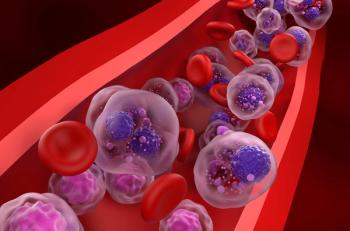
An Integrative Efficacy Score May Be Effective to Evaluate Drug Benefit in Oncology
An integrative efficacy score would incorporate the depth, duration, and prevalence of tumor response.
Despite being technically classified as drug failure and being diagnosed with progressive disease, many patients display clear treatment efficacy in a subset of cancer lesions, according to a presentation at the
Topp explained that a hypothetical patient could have multiple lesions throughout the body. After receiving treatment with pembrolizumab, some lesions may shrink, some may stabilize, and still others could grow.
Because of the growth of some lesions, however, the patient would be considered to have progressive disease. However, Topp questioned whether this necessarily means drug failure, and whether treatment with pembrolizumab should be discontinued in this instance.
Throughout his presentation, Topp used data from the KEYNOTE-001 study of pembrolizumab in melanoma, although he noted that similar outcomes have been seen in multiple indications. In this study, 511 patients qualified for the analysis, 313 of whom developed progressive disease. Of those, 200 had primary progressive disease before 14 weeks, 113 had secondary progressive disease after 14 weeks, and 198 showed no progression.
Patients with primary progression were the most severe cases, Topp said. Approximately half of these patients saw growth in the size of lesions, and the other half decreased or stabilized. Only 46% of lesions actually progressed, however, and Topp emphasized that this is less than half. If a hypothetical patient had 5 total lesions and 1 grew while the other 4 shrank, Topp argued that this should not constitute drug failure.
Additionally, among patients with secondary progression, approximately one-third showed a rebound, whereas the other two-thirds developed progressive disease because of the appearance of a new metastatic lesion. These patients were then classified as drug failure, despite the fact that their pre-existing lesions may have shrunk.
“What we’re calling drug failure is characterized by continuing efficacy in the majority of lesions,” Topp said.
A common assumption of secondary progression is that the lesions shrink before growing again, but Topp said that this is not necessarily true. What often happens is that the lesion shrinks before stabilizing at that smaller size, and another, new lesion may appear elsewhere in the body.
In a patient example, Topp said a patient was diagnosed with progressive disease at 12 weeks due to the appearance of a new metastatic lesion, but they were essentially deemed a complete responder at 3 years. The original lesion completely disappeared and another one appeared briefly, but it disappeared as well, and the patient has now survived on pembrolizumab at 5 years.
When considering what a “good” patient response looked like, Topp emphasized that every lesion should be shrinking or stable.
“If you want to get a patient to survive for a long period of time, you need every lesion stable or shrinking,” Topp said.
Finally, Topp discussed heterogeneity in patients treated beyond the time of progression with pembrolizumab. In the KEYNOTE-001 population, nearly 50% of patients continued to receive pembrolizumab even after a diagnosis of progressive metastatic disease. Among the subset of patients with growing tumors, 6 patients’ tumors continued to grow, 24 grew then stabilized, and 7 had tumors that grew and then shrank.
Among those whose tumors stabilized, some were stable before growing again, some remained stable, and some shrank after being stable for an extended period. Finally, among those whose lesions shrank, some continued to grow smaller, some shrank then stabilized, and a very small percentage rebounded, according to Topp.
Notably, 24% of patients showed a response in their tumor dynamics in the post-progression space and 60% showed tumor stabilization, which Topp said is a very surprising number. Clinicians tend to assume that when a new metastatic lesion appears it will continue to grow, but only about one-third of patients followed this expectation. Nearly half stabilized, and between 20% and 25% saw the lesion appear and then disappear.
Most importantly, Topp emphasized that although it is defined as disease progression, the new lesion continues to grow in only a small percentage of patients. Based on all of these findings, Topp questioned whether current definitions of progressive disease and measurements of drug failure are adequate. He suggested an integrative efficacy score to address these concerns, including more comprehensive data on the patients’ responses to treatment.
Most patients do show some degree of efficacy, Topp concluded, but the majority of patients are diagnosed with progressive disease and are considered drug failure. An integrative efficacy score would incorporate the depth, duration, and prevalence of tumor response, and would give clinicians more tools to evaluate treatment options.
“What we need to do is maximize the percentage of lesions that are responding,” Topp concluded.
REFERENCE
Topp, B. Lesion-to-lesion heterogeneity in response to pembrolizumab. Presented at: 2022 International Cancer Immunotherapy Conference. September 29, 2022.
Newsletter
Stay informed on drug updates, treatment guidelines, and pharmacy practice trends—subscribe to Pharmacy Times for weekly clinical insights.






































































































































































































